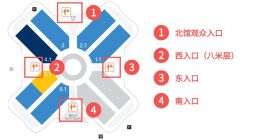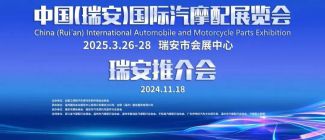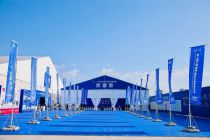On October 30, 2025, at the 13th Automotive and Environmental Innovation Forum, Lu You, General Manager of NeueHCT Products and Marketing at Zhijia Continent, introduced Zhijia Continent's business layout and development philosophy. Adhering to the concept of "based in China, serving China and the world", Zhijia Continent has planned two product lines: the Haoyue HCT Luna, which focuses on "safety equality", and the Starry HCT Astra, which provides full scene NOA functionality. Lu You also analyzed the advantages of single-stage and two-stage schemes. He pointed out that the one-stage approach has more advantages in user experience compared to the two-stage approach, which can significantly improve driving coherence, personification, and safety. At the same time, it has strong generalization ability and can quickly adapt to different driving habits in different regions. In addition, based on the Horizon Single J6M computing solution, the one-stop end-to-end solution of Intelligent Driving Continent can effectively control costs while improving user experience.

The following is a summary of the speech content: NeueHCT (hereinafter referred to as "Intelligent Driving Continent") was established in 2022 and has offices in Shanghai, Nanjing, Beijing and other places in China; Our international headquarters is located in Singapore, and we have local employees in Japan, Europe, India, and other overseas locations, as well as deployed demo resources. Since its establishment, Zhijia Mainland has adhered to the concept of "based in China, serving China and the world", iterating advanced technology solutions in China's research and development base, and continuously promoting them to the global market. During this process, Zhijia Mainland has rapidly promoted the implementation of relevant technologies in various regions and continues to maintain close communication with customers. For domestic intelligent driving suppliers, expanding their business overseas has always faced many challenges, one of which is data. At present, the intelligent driving mainland is focusing on improving relevant capabilities and has established an overseas data closed-loop system, and has conducted road testing in compliance with regulations in multiple countries overseas. Currently, Zhijia Continent has planned two product lines, namely HCT Luna and HCT Astra, named after the moon and stars. When deciding on this name, Zhijia Continent has carefully considered it. For users, one of the core values of intelligent driving products is the ability to escort them safely home. Therefore, Zhijia Continent named these two product lines Luna and Astra, hoping that they can illuminate users' way home like starlight and moonlight, ensuring their safe arrival.
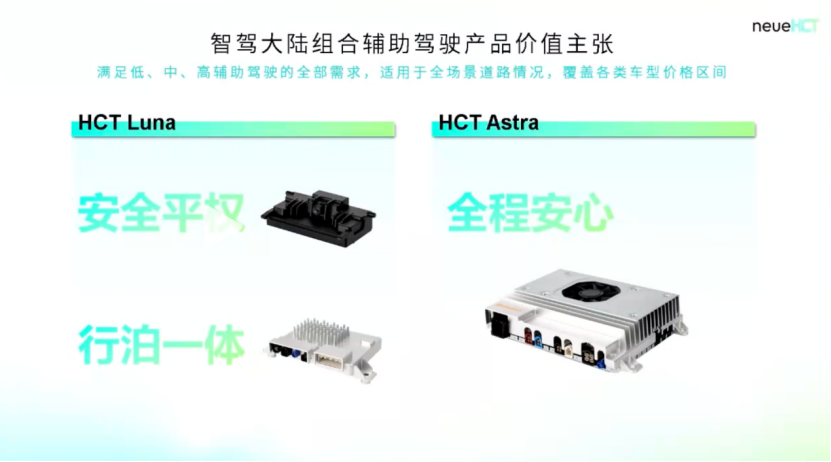
The HCT Luna product line focuses on the concept of "safety equality". For all vehicles, it is necessary to ensure the safety of the vehicle, the safety of the driver, and the safety of people outside the vehicle, which is the bottom line that Zhijia Continent adheres to. On this basis, Intelligent Driving Mainland hopes to integrate driving and parking functions at an extremely low cost, creating a cost-effective integrated product for driving and parking, thereby achieving "safety+intelligent equality". The positioning of the HCT Astra product line is to create a better high-end experience for users. Astra provides a full scenario NOA function, allowing users to travel from home to destinations such as offices or shopping malls without worrying about driving, checking navigation, or collision risks. Zhijia Continent hopes to provide users with a reassuring experience throughout the entire journey through Astra products. Currently, most mass production solutions in the market still adopt a two-stage algorithm architecture design. Although the one-stage approach has many advantages, there are also many urgent problems that need to be solved. For the next generation solution, while ensuring security, two core issues need to be addressed: how to improve user experience and how to effectively control costs. The core goal of Zhijia Continent is to enable more users to use such products, rather than just pursuing excellence in product performance. Zhijia Mainland believes that the true next-generation solution must meet both the requirements of "improving user experience" and "achieving controllable costs" while ensuring safety. Firstly, it is necessary to clarify the core difference between two-stage and one-stage schemes. For example, in the two-stage scheme, the perception and control module adopts a segmented design, involving software post-processing flow and decoupling of horizontal and vertical control. Therefore, drivers and passengers sometimes clearly feel the "seamless feeling" of vehicle operation under the two-stage scheme.

Taking the common and technically easy scenario of turning right at an intersection as an example, in the two-stage approach, after entering the intersection, the steering wheel operation of the vehicle will appear cautious, as if a driver with a different driving style has changed; After exiting the intersection and entering the next straight section, the driving style returned to normal. Many two-stage solutions suffer from such issues. In the recently launched segmented solution of Intelligent Driving Mainland, the vehicle's coherence performance in such scenarios is excellent. The one-stage solution reduces the sense of splicing in scene switching and greatly improves the simulation and experience compared to the original solution, which can provide a better user experience. Although the two-stage approach is continuously improving in indicators such as collision and takeover frequency, the one-stage approach has natural advantages in many aspects. For example, on a continuous road, the one-stage scheme relies on its de scenarization feature. When facing complex road conditions such as sharp corners and irregular intersections, the vehicle's movements during left and right turns and detours are smoothly connected without any lag. The driving performance of the vehicle is extremely close to that of a human driver and can meet the user's expectations. The consistency of expectations is crucial for such systems, as when users have a clear understanding of the vehicle's driving intentions, there will be no sense of panic; On the contrary, if the operation of the vehicle does not meet the user's expectations, the user will continue to focus too much on the system's operation and ignore the road conditions, which is even more unsafe. For the end-to-end solution that adopts driver expert information imitation learning, the smoothness of the vehicle's driving path is high, avoiding problems such as action interruption and unreasonable lateral sway. At the same time, the simplification of the architecture results in shorter system response delays, even lower than the reaction time of human drivers in most cases. Overall, a one-stage solution can bring higher performance limits through a more optimized architecture. During the mass production process, Zhijia Mainland pays great attention to safety assurance issues. In a one-stage approach, the sources of perception are more diverse, and the model directly utilizes many intermediate results and even raw data. In this case, the final perceptual performance often outperforms traditional independent perceptual models. In an end-to-end architecture, vehicles act as if they are "driving while looking at images", while taking into account the results from various levels to ensure safety. Therefore, from a security perspective, the one-stage solution presents a natural improvement advantage, coupled with safety rules as a backup, its security performance exceeds expectations and has enormous potential for improvement.
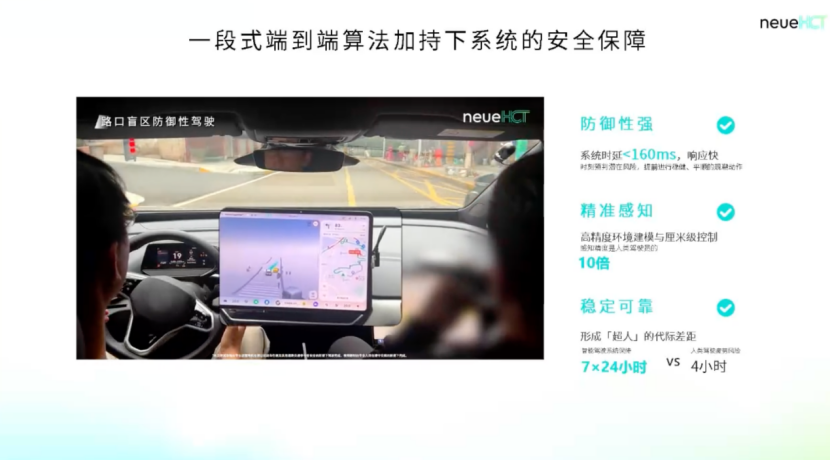
In some specific scenarios, relying on preset rules and adopting a two-stage approach can easily lead to rule conflicts in many situations. Taking the scene of blind spots caused by the obstruction of large vehicles at intersections as an example, human drivers will slow down first, observe the surrounding environment, and then accelerate through intersections or zebra crossings in actual operation. HCT Astra's end-to-end version also adopts this behavior. This behavior is not achieved through rule writing, but through learning. In this process, what needs to be done is to carefully select the data and standardize the driving behavior in the data. In this way, the entire development process and adaptation work in different regions will become highly unified, achieving a high degree of automation. Therefore, this model has a natural advantage in terms of generalization. Taking the test in Chongqing as an example, the intelligent driving mainland has never conducted relevant tests in Chongqing before, but the system showed good performance on the first day of driving. This is also because, in a data-driven mode, the system can cover a large number of similar scenarios that exist in different cities, and only needs to solve a small number of special scenario problems. Compared with the previous approach of writing different rules for different cities, this model significantly improves the iteration pace, development speed, and generalization applicability of problem solving. In September of this year, we conducted field tests in Germany. Test feedback shows that most of the issues are not focused on technical aspects such as performance, accuracy, and latency, but rather on some questions about driving behavior raised by European colleagues. For example, they asked why the system would choose to play with vehicles in the left lane when overtaking. This operation is considered a highlight in China, but it is not accepted in Europe and should wait for vehicles in the left lane to pass before changing lanes. In addition, they also pointed out that overtaking on the right side should not occur in Europe, otherwise it will trigger complaints. In response to these issues, Zhijia Continent has found that as long as there is corresponding driver data, the model will naturally absorb these driving habits without the need for additional modifications to the rules. Taking the convergence scene as an example, in China, drivers may choose to avoid and change lanes; In Europe, drivers believe that the other vehicle will follow the rules and will not suddenly rush in, so they can drive directly, otherwise it will affect other lanes. It can be seen that there are differences in driving habits among different countries and regions, and targeted adaptation is needed. For a one-stage solution, performance is not a challenge as it can reach a high level in different regions. What really needs to be focused on is how to adapt to the driving habits of different regions.

The answer given by Intelligent Driving Mainland at present is about how to improve user experience and achieve more controllable costs, so that more users can use better products. This end-to-end solution can be run based on the Horizon Single J6M computing solution, and can still provide excellent user experience under limited computing power and cost conditions. Although Zhijia Mainland has not been established for a long time, it has obtained many project designations, including mass production projects outside Chinese Mainland. From the end of this year to the second half of next year, multiple models will gradually achieve mass production worldwide. The understanding and practice of intelligent driving in mainland China in overseas markets, the construction of overseas data loops, and overseas adaptation have shown initial results in the past year. In the future, Intelligent Driving Mainland hopes to promote China's advanced solutions to all continents of the world, providing high-quality services, excellent experiences, and reliable safety guarantees for global users.

 English
English Chinese
Chinese





